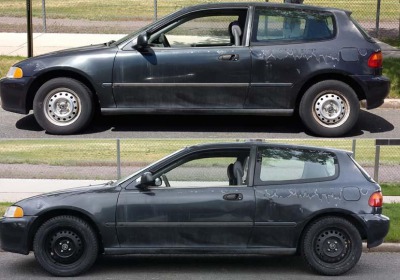Cheap mods: Adventures In Aspect Ratios
Fri, 16 May 2014
Seven years ago, I bought a rough-looking-but-good-running 1992 Honda Civic DX hatchback, for use as a gas-sipping alternative to my daily-driver P71 Crown Victoria. These days, it's the car I drive when it snows in Denver, and it's a reliable all-around beater.
The EG Civic (as the 1992-95 Civic hatchback was designated by the factory) has become a much-sought-after classic in recent years, sort of the '55 Chevy of the early 21st century, and there's such a vast array of factory and aftermarket performance hardware available that I haven't been able to resist the idea of doing some power and suspension upgrades. Ideally, I'd like to get my Civic so it's suitable for track days at the local road-course track, as well as test-and-tune fun at the local dragstrip.
Unlike just about every other EG owner out there, however, I want this car to retain the external appearance of a well-used commuter junker, because sleepers are fun! Wheels and tires can be difficult on a car like this; it came with 13-inch wheels from the factory, and there's just about zero selection of decent tires in that diameter these days. Is it possible to get stock-looking 15-inch wheels on the car and not de-sleeperize it?
The '92 Civic DX's D15B7 engine made 102 hp when new. At sea level. Up here in the thin air of Denver, it makes much less power. Here's a shot of my car running a cement-mixer-like 18.235 seconds at Bandimere Speedway.
Fortunately, there are many potent engines that bolt right into the fifth-gen Civic. The B18C1 was used in the mid-'90s Integra GS-R and made 170 hp. Here's one in my garage, awaiting a swap. I've also pulled Integra brakes and suspension parts at my local wrecking yard. And, of course, I'll probably add turbocharging, because it's the law.
I won't be slamming my Civic to within several atoms' breadth of the tarmac, though, because it needs to look stock and it's nice to be able to use one's beater to haul, say, greasy Chrysler 318 short-blocks when needed.
The car came with silver-painted 13-inch steel wheels from the factory, and the previous owner installed a set of rock-hard Toyo Spectrum tires on those wheels. By my calculations, these tires had over 100,000 miles on them, and still showed no discernible tread wear. They offered just about zilch for grip, making for some exciting moments on winding mountain roads.
I wanted to stick with steel wheels that looked similar to the ones that came with the car when new, but (as far as I can tell) Honda never put steel 15-inch wheels on the Civic. Fortunately, it turned out that some Honda Fits were equipped with steel 15-inch wheels of a style very similar to the ones used on the fifth-gen Civic, and I found a set of four on Craigslist for $75. The holes around the outer edge of the Fit wheel come in two different sizes (in order to balance the weight of the tire-air-pressure sensor), but this is not obvious at a glance. For tires, I went cheap and got the great-bang-for-the-buck Primewell PZ900, a very popular choice among 24 Hours of LeMons racers. The 175/70R13 tires had a sidewall height of 107.25 mm, but I wanted to fill the wheelwells just a bit more, so I got 195/55R15s and a 122.5 mm sidewall height. This means the wheels spin a bit more slowly, but my speedometer always read fast with the Toyos and, ideally, the larger-diameter tires will compensate.
Here's how the car looked with the old tires and wheels.
And here's the new setup. I may paint the new wheels silver, because it looks a bit more racy than I'd like with the black steelies, but that might highlight the low-aspect-ratio tires more than I want. Note that the '92 Civic center caps are correctly sized for the mid-2000s Fit wheels.
By Murilee Martin

